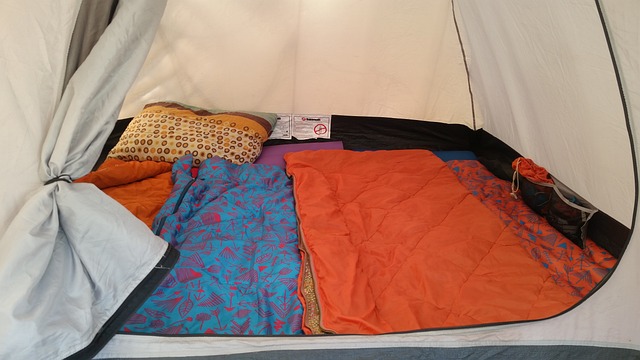How to Wash a Sleeping Bag? An Easy Step-by-step Guide

Cleaning your sleeping bag on a regular basis is necessary, just like cleaning your pillow, comforter, and sheets.
Not only can your body’s oils and sweat cause damage to your sleeping bag over time, but you frequently use it outdoors, which may involve (spoiler alert!) actual dirt.
No matter if your sleeping bag is made of down or a down substitute, we’ll show you how to wash it when it gets dirty. Before putting your camping gear away at the end of the season, this is a good thing to do.
To wash a sleeping bag, you are supposed to prepare tools and materials. Then, head to a laundromat, use the right cleaner, wash it, dry it, spot cleaning and hand washing.
While hand washing is more labor-intensive, using a washing machine is simpler and less expensive overall. Use a top-loading washer without an agitator (the center spindle that protrudes from the middle of most top loaders), as this can cause your bag’s seams to rip. Without an agitator, a front or top loader should work just fine.
Table of Contents
What You Need
Wash and Dry
The safest way to wash a down bag is by hand in a bathtub or in a large enough washing machine without a central agitator. The stitching on the bag won’t be damaged by a front-loading washer, but a top-loader’s agitator might. You might need to go to a laundromat to use an extra-large machine if you’re dealing with a two-person sleeping bag that won’t unzip into two pieces.
A large enough clothes dryer: Once more, you might need to visit a laundromat to use a dryer there if you have an extra-large bag or a small machine.
Are you not interested in tennis? Here are some fresh tennis balls. You can also use wool dryer balls.
Keep Your Bag Clean
A sleeping bag liner is a good idea to have inside of your bag. These are typically thin, bag-shaped, and made of silk. We like Sea to Summit’s Silk Stretch Mummy Liner; it’s lightweight, wicks moisture, and is easy to pack.
A sleeping pad will be useful to place between your bag and the ground (or the tent floor). For car campers, we recommend the 3-inch-thick Therm-a-Rest LuxuryMap, which is as comfortable as any similar pad and easier to inflate, deflate, roll, and store. For backpackers, we’d suggest the Therm-a-Rest NeoAir XLite—it’s light, warm, and comfortable, and it packs down to the size of a 1-liter Nalgene bottle. (It also comes in a scaled-down, slightly warmer women’s version—good for people who are smaller in size and who tend to sleep colder.)
A folding drying rack, the back of a chair, a shower curtain rod, or even the ground will work in the absence of a clothesline.
A dampened cloth: It’s a good idea to keep a dampened cloth on hand for when you need to spot-clean your bag.
A large storage sack: Most sleeping bags come with both a small stuff sack (for carrying your bag) and a larger storage sack; in this case, we’re referring to the latter.
How Long Will This Take?
Depending on whether you’re washing your sleeping bag by hand or in a machine, it could take anywhere from an hour to two hours.
Up to three hours will be needed to dry it. And to make sure it’s completely dry, you might want to hang it up overnight.

How to Wash a Sleeping Bag?
Head to a Laundromat
Your best option is to visit a laundromat to use industrial-sized machinery and a front-loading washer since your home washer and dryer aren’t quite strong enough to clean your sleeping bag. Never use a top-loading washer with an agitator column; the bag might twist and rip around it.
“If you’re using a zero-degree or alpine bag with large baffles, hefty loft, or high-quality insulation, I always recommend putting it in a larger washer,” says Manager at Rainy Pass Repair, Kipp Godfrey. “The water can be drained using a large drum. Your home washer or dryer won’t work as effectively if you overload it.”
Use the Right Cleaner
Never use regular laundry detergent to wash your sleeping bag, and never dry clean it. “Where people consistently go wrong with DIY cleaning is using the right cleaner,” Godfrey says. “You might get down clumping if you use a typical detergent or household cleaner.”
Make sure to read the care instructions. Check the manufacturer’s website for cleaning instructions if you’ve torn off the tag.
Wash It
The basic water temperature and spin cycle should be covered in the care instructions on the bag, but in general, you should use cold or warm water—never hot—and run it through a second rinse cycle.
Dry It
Move the bag to the dryer on a low heat setting after it has been washed and rinsed. Verify the cleanliness of the lint filters. Tennis balls can be added to a down bag to keep the loft up. Tennis balls are not required for synthetic bags.
“Drying takes a long time,” Godfrey says. “An industrial dryer is useful for this reason. Lower temperatures will improve the efficiency of heat transfer.”
Spot Cleaning and Hand Washing
You’re better off washing your bag in its entirety rather than trying to spot-clean it. However, you can spritz and dab your bag with a cleaner to remove any troublesome stains or marks.
In an emergency, you can hand wash your sleeping bag in a sizable tub or basin of soapy water if there isn’t an industrial washing machine available. Use your hands to wash and rinse the bag after adding a small amount of cleaner to warm water. If air drying is your only choice, it will work, but be aware that it will take a while for the bag to dry completely.
Read about Best Washable Dog Beds
Treating Stains on a Sleeping Bag
If you’re outdoors and exposed to the elements, stains on your sleeping bag are probably going to happen. A waterproof or water-resistant outer lining is common in sleeping bags, which is advantageous if you can clean up a spilled liquid quickly before it reaches the fibers. Other typical stains include mud, grass, oil, food, and occasionally blood. A stain removal technique is most effective for each type of stain.
An enzyme-based stain remover can also be used; pre-treat the stain 15 minutes before washing by rubbing the stain remover into the stain with a soft-bristled nylon brush.
Care and Repairs
Regularly check your bag to make sure the seams, zippers, and drawcords are in good condition. To check if the insulation is distributed evenly, feel it. Small tears or holes can be patched with fabric or stitched shut with a needle and thread. Bring the zipper to a qualified tailor if it needs to be replaced.
A new down sleeping bag may occasionally have down or feathers peeking out, particularly near the seams. It’s common for down and feathers to test the seams of new bags before they settle. Push any quills that are visible poking out back inside. It should seal up the tiny hole it created.
If your sleeping bag has a special waterproof coating and you see that it is absorbing water and becoming soggy, it’s time to reapply the waterproof coating. The original DWR (durable water repellent) finish on a sleeping bag’s shell eventually deteriorates (depending on usage, this could take months or years). If you reapply this finish, a DWR product can revive water resistance and aid in keeping the bag clean.
Store a Sleeping Bag
Before storing the sleeping bag in a permeable cotton or mesh bag, make sure it is completely dry. To stop the growth of mildew, keep the bag in a cool, dry area at all times. Avoid storing things in damp basements and unheated (and uncooled) areas like attics, garages, and car trunks.
How Often to Wash a Sleeping Bag?
Wash the bag at least once a year or at the conclusion of each camping trip. Purchase a sleeping bag with a detachable, washable liner. After each use, wash a liner. Your bag stays cleaner longer if the liner is clean.
Use a clean cloth and warm, soapy water to wipe the sleeping bag after every ten uses. Turn it over and hang it to dry naturally.
Tips for Washing a Sleeping Bag
- Use a sleeping bag liner, which is much simpler to clean. Choose fleece or insulating synthetic performance fibers for a warmer liner if you want something lightweight like silk or cotton. You can purchase a separate bag if yours does not come with one.
- Open the bag flat after each use to let it completely air and dry.
- Protect your sleeping bag from the ground with a tarp to keep it cleaner for longer.
- Sleeping in clean clothes every night is another suggestion for keeping the bag clean.
FAQs
Will Wash a Sleeping Bag Ruin It?
A sleeping bag should only be washed once a year or as needed because frequent machine or hand washing can reduce its insulating qualities. You can prolong the life of the bag’s cleanliness by using a removable, washable liner to keep sweat and body oils off of it.
How Long Does It Take for a Sleeping Bag to Dry?
A down or synthetic-fill sleeping bag can be machine dried on low for 3 to 5 hours or dried by hanging up. In contrast to down, synthetic fill typically takes longer to dry.
What Can You Do About Mold, Mildew, Or a Musty Smell in a Sleeping Bag?
Apply full-strength vinegar to any blemishes to kill and remove mold and mildew. It will disinfect the sleeping bag and eliminate spores.

![13 Best Hamster Bedding In 2022 [Updated]](https://www.myspacebeds.com/wp-content/uploads/2022/09/13-Best-Hamster-Bedding-In-2022-Updated.jpg)


















![Silk & Snow Hybrid Mattress Review Should You Buy It Or Not [2022]](https://www.myspacebeds.com/wp-content/uploads/2022/11/Silk-Snow-Hybrid-Mattress-Review-Should-You-Buy-It-Or-Not-2022-520x293.jpg)